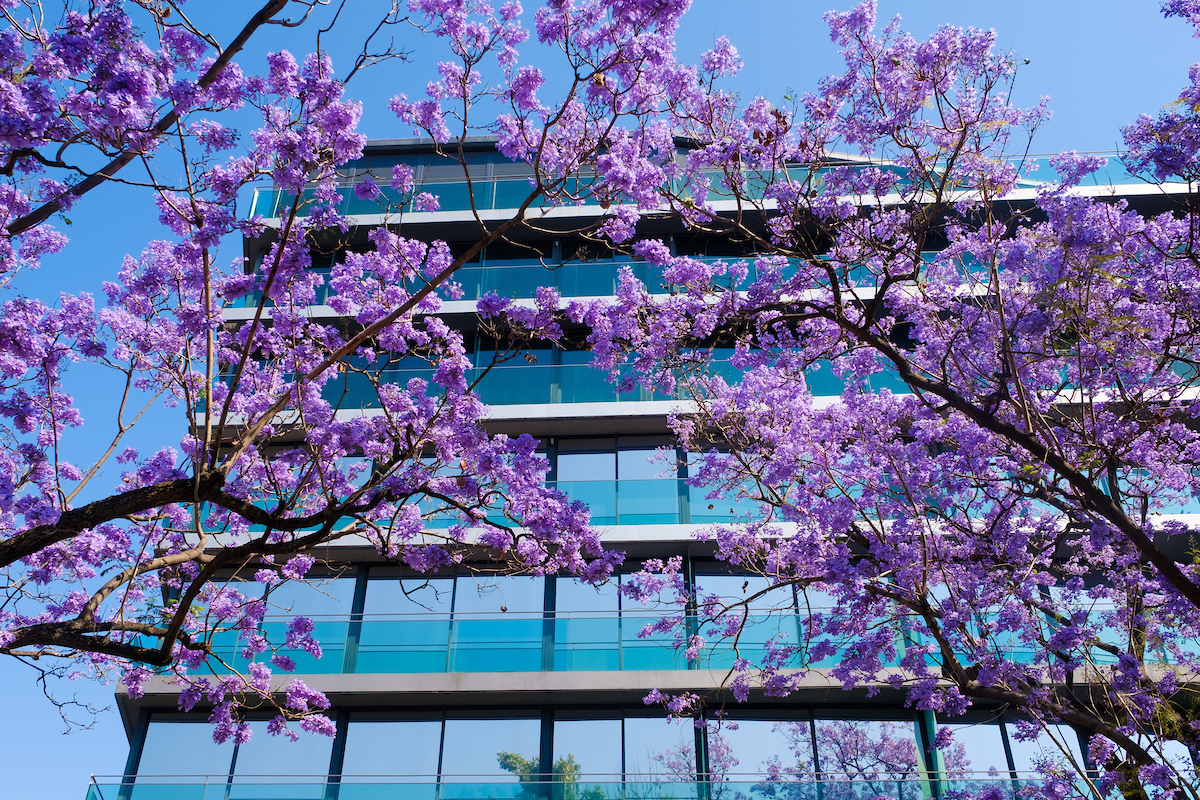
Some claim that the best view of the lilac-blue hue with which the jacarandas paint Lisbon at this time of year is from the Tagus. It might be true, especially because the city and its openness to the sea have everything to do with the history of these trees in the city. It was with the sway of the winds that brought the ships back to the Tagus that the jacaranda seeds also came, in the early 19th century.
The Jacaradás came from Brazil. First, to the Ajuda Botanical Garden. Then, to be spread out through the city.
The Jacaranda mimosifolia blooms in Lisbon before the summer, from May to June, and it paints Lisbon with lush lilac-blue patches, in squares and streets. It’s an exotic tree, native to Argentina, Bolivia, and Paraguay, and it has adapted well to our climate.
Men took on the role of the birds, dispersing seeds making them travel the world. Who brought jacarandas to Lisbon? Felix Avelar Brotero, none other than the father of Botany in Portugal, who directed the Ajuda Botanical Garden from 1811 to 1826. As a good practice, inherited from his time in Paris, similar to what he did with other species, he also offered the seeds of this tree to anyone who wanted to cultivate them around the city. After all, he had them at his fingertips to sow.
From Ajuda, spreading jacarandas throughout Lisbon
Dalila Espírito Santo, the engineer who also directed this Botanical Garden from 2002 to 2019, confirms that Brotero would advertise: “It’s a beautiful tree for Lisbon”. For the former director of the garden, this serves as evidence of his role in spreading the species that is now found throughout the city.
The plant’s introduction predates the Brazilian Court’s return from Brasil, at a time when blue spectrum pigments were of extreme value. For royalty, however, Jacarandás had much more a non-commercial value: it was a way to demonstrate royal power.
“Exotic elements, such as the jacaranda, served as a kind of television of the time”, for nobles and commoners alike, explains the specialist. It’s no coincidence that King D. João VI, decided that the Botanical Garden should open to the public every Thursday when he returned to Portugal. If it still impresses us today, despite the stimuli we are exposed to, imagine the impact it had at the time!

The two trees in the Botanical Garden, perhaps because they were the first to acclimate to Lisbon, are the last to bloom in the city, which perhaps reassures them that they will have a more exuberant flowering than the others that once sprouted from them.
The heat brings the purple flowers to the jacarandas
The Jacaranda mimosifolia seems to be in a counter-cycle with its posture, both in leaf shedding and flowering. But the gardener Nuno Prates clarifies that “the tree is being consistent with its cycle, having a fleeting period without leaves”. The flowering is triggered by temperatures that would have the same effect in Latin America and are only reached here in the announcement of summer in late spring.
This need for high temperatures prevents the tree from being a good choice for areas north of the Tagus River – so it stays here, in Lisbon. Nuno also explains that, subtly, this species typically blooms a second time, here or on the other side of the Atlantic, following the seasons and temperatures.

Although Lisbon has a great reputation for its jacarandas, the true world capital of jacarandas is Pretoria, in South Africa – also far from its origins. Some botanical books claim that the Portuguese were responsible for spreading this species there, as well as in other countries and continents. However, in those parts, because the conditions for its flowering are met during exam time, superstition says that the falling of a flower on one’s head, something quite likely, means luck in exams.
Argentinian poets, attentive to sounds that only certain ears hear, swear that these trees sing tangos to those who pass beneath their canopies. Here, on another note, Eugénio de Andrade sang a poem to them: “I know of no other glory, no other paradise: at their entrance the jacarandas are in bloom, one on each side. And a smile, tranquil abode, awaits me. The space all around multiplies its mirrors, opens balconies to the sea. It’s like in the most childish dreams: I can fly almost touching the high clouds – brother of the birds -, lose myself in the air.”
A subject of odes for the famous poet and a source of delight for many Lisboetas, the jacaranda will, however, continue to be the tree of our discord: either because of the odor that doesn’t please everyone or because of the idea that it dirties – sidewalks and parked cars. It might be worth knowing that the tree is especially important for the urban environment, not just for beautification, but for the environment. And that its resilience to the two main attacks it faces depends on it: pruning and pollution.

Until September, another flowering
Until the end of June, the spectacle of jacarandas in bloom can be seen, without invitation, in the most diverse corners and nooks of Lisbon, but the main highlights are Largo do Rato, Parque Eduardo VII, Largo do Carmo, Av. D. Carlos I, and Av. da Torre de Belém. But if for some reason it escapes your sight now, remember that the tree will bloom again in September. More timidly, perhaps due to the cold, without shedding its leaves again so that the lilac-blue stands out.
*This article was first published at the end of May 2021.
A thank you, in addition to those mentioned in the article, to Teresa Chambel and Luís Mendonça de Carvalho, who helped guide the article.

Leonardo Rodrigues
Nascido na Madeira, o seu coração ficou por Lisboa. Estudou comunicação na FCSH – UNL e fotografia no Cenjor. Depois de muitos ofícios, é a contar histórias que se sente bem. Acha que não existem histórias pequenas, anseiam é por ser bem contadas. Quando não está a escrever, é aprendiz de jardineiro. @leonismos no Twitter.

If you like what you’ve seen us doing, if you get inspired by our stories, if you care about a new Lisbon, more engaging and liveable, if you see any use in this journalism, communitarian and close spare a little bit of your time and consider donating. If you want to be part of this community – join us!

Tudo o que torna a ” nossa ” Lisboa” mais linda e de partilhar para a tornar a mais Bela do Mundo…! Nao Esquecer as roseiras ,as ‘ sardinheiras’ plantadas as janelas ou os cravos de Abril…
Adorei esta informação, até porque já tinha intenção de a pesquisar uma vez que estás árvores sempre me impressionaram bastante em Lisboa onde sempre aprecio a sua grande beleza.
Não sabia a sua origem e agora aprendi sobre elas.
Foi muito útil esta informação!